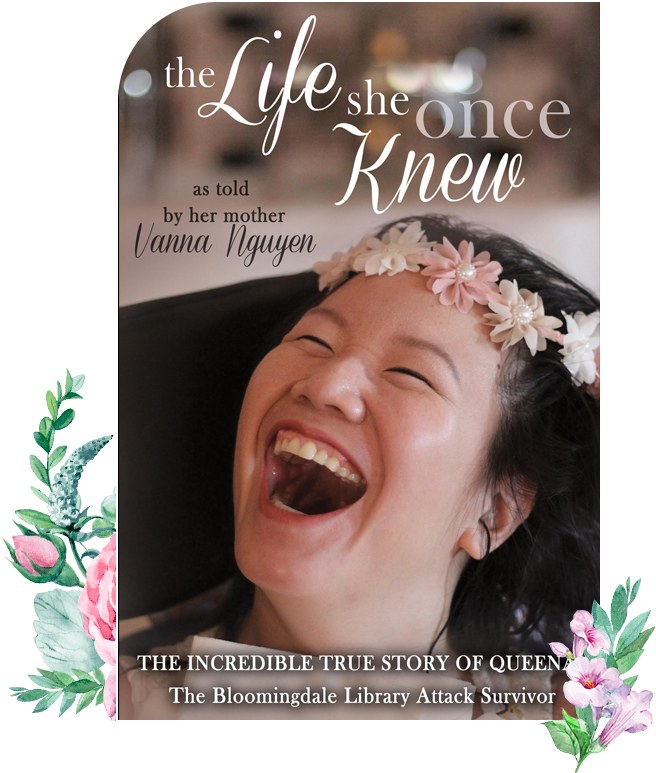Naturally, the most frequently asked question from those that follow, support, know, and love Queena is…”how is she doing?”.
From the family’s perspective, we can say that she is happy, healthy, and becoming stronger and more alert every day.
But let’s see what others have to say. We asked five of her therapists to describe what it’s like to work with Queena and to note any progress that they have recently seen.
Therapy sessions are not easy for Queena. It takes a sense of confidence and commitment, a positive attitude, the ability to endure pain, the strength to keep trying again and again, and bravery above all else.
Her therapists explain what Queena is like during these sessions. Mayra, her speech therapist says, “It is an honor and a pleasure to work with Queena. Over three years ago I got a bad haircut. To this day, any time I say ‘hair’, or if I catch her looking at my hair, she immediately laughs! This not only allows her a way to express herself but shows her amazing memory and sense of humor.” Her speech therapist Donald states, “She is responsive and willing to learn, and she is a motivated learner. It is a pleasure to go out to work with Queena and her family. During her therapy visits, Queena is happy and follows verbal cues and directions with a smile. Queena is a wonderful and pleasant person and patient to work with. She continues to have a great smile and very good attitude during speech, language, and swallowing therapy provided during the week.” Dan, her physical therapist notes, “I am pleased to report that Queena’s response to physical therapy over the past few months is encouraging as well as remarkable. In order for any progress to occur we, physical therapists, need the patient to be ready for the challenge and willing to participate. Queena’s attitude is perfect for the challenge. She is able to listen to requests and try to move her body accordingly. It is a challenge in many ways for her, but she continues to make the effort. With these notable developments and Queena’s “Hear Me Roar” drive to overcome, Queena has what it takes to continue to participate with the challenges we present her with to promote independent mobility.”
Queena’s Notable Accomplishments
She controls her head movements
“The most significant improvement that I have seen in Queena is her ability to control the movement of her head from side to side. Also, the deep spasms in her hamstring muscles are less as well as episodes due to sinus conditions.” – Yvette (acupuncture)
She produces more vocalizations and attempts at words
“She’s improved her head control now so that she can activate a new communication device just by small head movements. She is using many vocal sounds to answer yes/no questions and to express concern, agreement, and other thoughts and feelings. Queena continues to make steady progress towards being able to communicate and interact with others. She prefers deep tissue release techniques to decrease her muscle tone and tightness in her back, shoulders, neck and face. Being more relaxed helps Queena improve her posture and head position, all of which are vital for her ability to swallow, improve her breath support in order to communicate with vocalizations, make eye contact, and so many other important functions. She is producing more vocalizations and attempts at words to share her thoughts and feelings. Her easiest way of communicating is her laugh. Queena is exploring a new way to communicate with a communication device that uses slight head movements to access the device. With this new way to access her communication software, Queena can quickly find the words she needs to request, to answer questions and make comments. The device uses a synthesized voice to speak for Queena. It can also access Microsoft Word and the Internet, which Queena hopes to one day use to further her education.” – Mayra Leavitt (speech & language therapy)
She controls her voluntary movements
“Queena has made significant progress within the last year. She is relearning to control her voluntary movements, through relaxation and breathing technique.” – Lan Nguyen (occupational therapy)
She responds with improved visual tracking and verbal comprehension
“She has improved verbal auditory comprehension and verbal retention following simple verbal directions. Vocal communication has increased with improved augmentation in order for her to express herself for current daily living needs. Queena is alert and responsive with improved visual tracking and identification of people, and various familiar concrete objects in her environment. Queena follows simple verbal directions and continued communication progress is expected. Queena will respond to tactile stimulation tasks, including oral motor exercises and volitional swallow tasks that are provided. She is a good listener and responds productively to verbal/auditory and visual cues and prompts that are provided. Queena appreciates that she is progressing with her swallowing skills including lingual mobility and dry swallow tasks. Queena’s swallow reflex has improved with increased oral motor activity and mobility of the labials. She is also responsive to question and answer tasks with increased vocal productivity and vocal inflection in her communication skills. She enjoys visual exercises such as visual tracking when clinician moves from her left side to her right side visual field which she becomes very happy with. During continued speech and language visits I am looking forward that Queena will continue to make good progress in her communication and swallowing skills.” – Donald Superfine (speech & language therapy)
She stands and kicks
“Queena’s most recent accomplishment is the ability to stand with the addition of a Tram Stander. This provides weight bearing to promote bone growth as well as a platform that enables free movement of her legs. With her L leg standing on a 4 inch platform, bearing her weight, freeing up her R leg for movement, when prompted, Queena can kick her leg as if kicking a soccer ball. Queena has the same success when the R leg is weight bearing and the L leg is free to move. We use the Tram for muscle reeducation and specifically the development of new neuro pathways for the motor neurons, which will enable Queena to move her legs as if to take steps which means the coordination of many muscle groups: quadriceps, hamstrings, hip flexors, gluteus maximums and not limited to gas trot nemius and anterior tibialis. Extensor tone is a problem for most patients with similar medical conditions to Queena’s, however Queena is learning and trying to control this inhibiting response which can interfere with motor control. I have recently noticed less tone and less tone duration, enabling us the ability to maintain range of motion, passively, in her lower and upper extremities as well as trunk. She is slowly beginning to demonstrate some of the primitive reflexes that as babies are ingrained without any practice. For example when sitting and falling to the side she knows that she needs to correct that by moving to the opposite side, and with assistance, she is able to.” – Dan Ferretti (physical therapy)
Medicaid covers only a small portion per year for certain therapies, while nearly $70,000 is required annually for all of the treatments that have helped Queena make such progress. These additional expenses are funded through the generosity of the community. A holiday shopping fair fundraiser, set to take place on Saturday December 13th, is currently being organized by her sister Anna to help raise money for these expenses. To find out more, visit http://www.joinqueena.com/fundraisers/.



